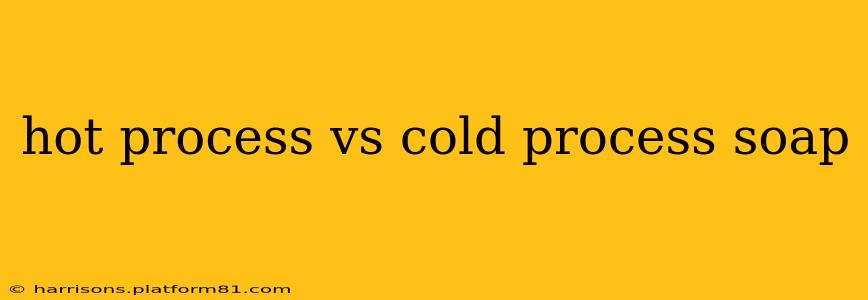Making soap is a rewarding craft, but choosing between hot process and cold process methods can be confusing for beginners. Both techniques produce soap, but they differ significantly in their process, resulting in soaps with unique characteristics. This comprehensive guide will delve into the key differences between hot process and cold process soapmaking, helping you decide which method is right for you.
What is Cold Process Soapmaking?
Cold process soapmaking involves a saponification process where oils and lye are mixed at room temperature. The chemical reaction generates heat, but it's not externally heated. This method requires a longer cure time (4-6 weeks) for the soap to fully saponify and become milder on the skin. The longer cure allows excess water to evaporate, resulting in a harder bar.
Advantages of Cold Process Soapmaking:
- More natural: Cold process soap often retains more glycerin, a natural humectant that benefits the skin.
- Variety of designs and colors: The slower process allows for creative designs, swirls, and the incorporation of various additives.
- Superior lather: Many soapmakers find that cold-process soaps produce a richer, more luxurious lather.
Disadvantages of Cold Process Soapmaking:
- Longer cure time: This method requires patience as the soap needs weeks to fully cure.
- Potential for variations: Achieving consistent results can be challenging, especially for beginners.
- Requires precise measurements: Inaccurate measurements can lead to unsaponified lye or a harsh bar.
What is Hot Process Soapmaking?
Hot process soapmaking accelerates the saponification process by externally heating the soap batter, typically using a double boiler or crockpot. This significantly shortens the cure time, often to just a few days. The heat cooks the soap, resulting in a harder, more stable bar quicker.
Advantages of Hot Process Soapmaking:
- Faster cure time: Soap is ready to use much sooner than with cold process.
- More consistent results: The heating process helps ensure complete saponification, reducing variations.
- Easier for beginners: The accelerated process makes it a more forgiving method for those new to soapmaking.
Disadvantages of Hot Process Soapmaking:
- Less glycerin: Some glycerin is lost during the heating process.
- Limited design options: The faster process makes it more difficult to create intricate designs or swirls.
- Can be harsh on sensitive skin (initially): Though fully cured, some find it can be a bit harsher on sensitive skin than cold process, at least initially.
What's the difference in the final soap product?
The most noticeable difference lies in the texture and cure time. Cold process soaps are often softer initially, developing a firmer texture over time. Hot process soaps tend to be harder and firmer from the start. Additionally, the color and potential inclusion of additives can differ due to the heat applied in the hot process method. Both, however, can be wonderfully moisturizing and cleansing.
Is hot process soap better than cold process soap?
There's no single "better" method. The ideal choice depends on your preferences and priorities. If you value a natural soap with a longer cure time and the opportunity for intricate designs, cold process is a great option. If you need quicker results and a more forgiving process, hot process might be preferable.
Which method is easier for beginners?
Hot process soapmaking is generally considered easier for beginners due to its faster cure time and reduced risk of variations. The accelerated saponification process makes it more forgiving for those learning the ropes of soapmaking.
Can I use additives in both hot and cold process soapmaking?
Yes, you can use many additives in both hot and cold process soapmaking. However, some additives may react differently to heat, so it's crucial to research the specific requirements for each ingredient before adding it to your soap recipe.
What is the shelf life of hot process and cold process soap?
Both hot and cold process soaps have a relatively long shelf life (1-2 years), provided they're stored properly in a cool, dry place away from direct sunlight and moisture.
This comparison should offer a clearer understanding of hot process versus cold process soapmaking. Ultimately, the best method is the one that best suits your individual needs and preferences. Experimentation is key to mastering either technique!
